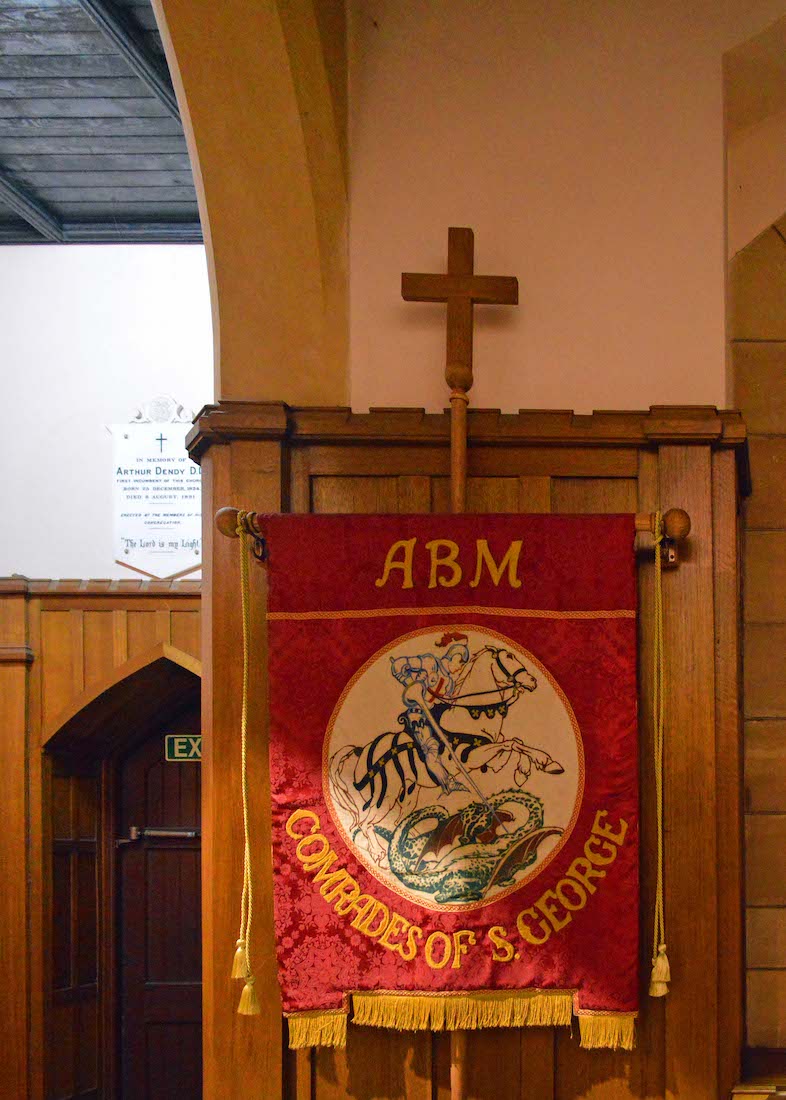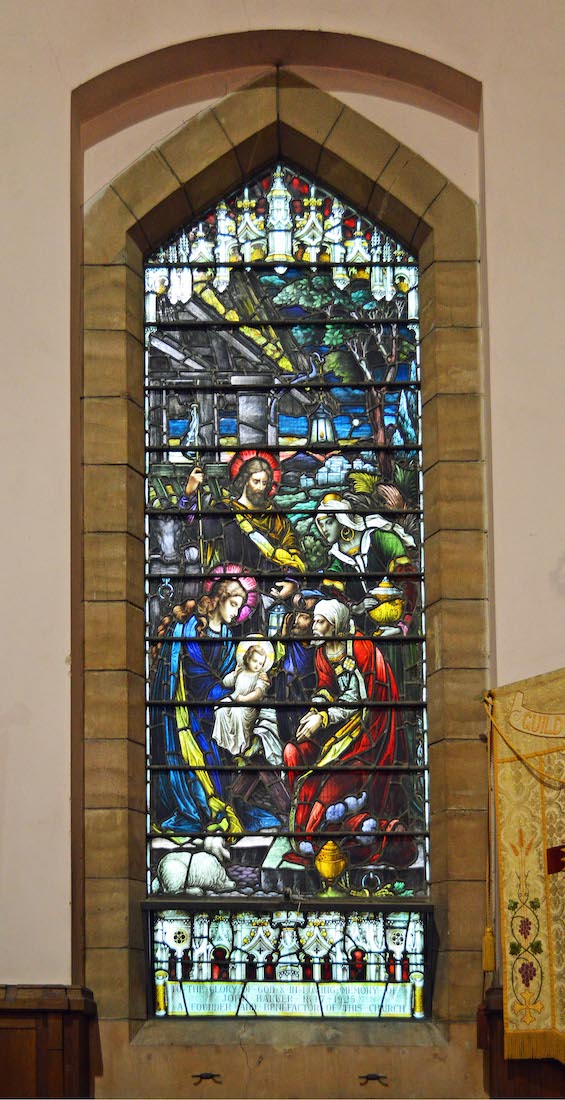
We move towards the Lady Chapel in the southeast corner. Some colourful kneelers line the pew at right, ahead there is a banner and a double lancet window, and to our left is the lectern. INDEX
42. KNEELERS

A wonderful row of kneeling cushions! In many churches this is an opportunity for the ladies (and men?) to be creative.
43. BANNER AND WINDOW
The banner celebrates the ‘Comrades of St George ’ – a national youth organisation which has since disappeared. The two lancets of the memorial window depict St Peter holding his keys of the kingdom, and St John with his writing quill. These windows were given in memory of Henry Charles Heath Denton 1882 – 1932 who was a Church warden and benefactor. Just above the door to the left of the banner we see a memorial plaque for Arthur Dendy.
44. LECTERN AND DENDY MEMORIAL
The Church lectern is a standard brass eagle. The origins of the eagle in this context are lost in history, but may be related to the eagle symbol for St John as one of the Four Evangelists. Arthur Dendy was born in Chichester, England in 1824. He was appointed Bishop’s Vicar and Preacher of St Peter’s Cathedral in 1876. After holding various other positions in South Australia he was the first incumbent of the original St Cuthbert’s Church in Prospect (1889 –1891).
45. CHILDREN’S CORNER
There is a little Children’s Corner tucked in by this side door. There is a West facing stained glass window, and several children’s prints.
46. LITTLE WINDOW
St Paul is pictured in the window holding a book and a very large sword. The book represents his epistles in the New Testament. The sword is a reminder of the means of his martyrdom – he was beheaded in Rome in AD 67. The window was created by Heaton, Butler and Bayne. It is in memory of Emily Grant Nesbitt who died 10 August 1924.
47. PICTURES
The most famous of these pictures is the child in prayer: ‘The Little Samuel’ by Joshua Reynolds.
49. LADY CHAPEL SIDE WINDOWS
The ladies depicted in the Eastern window shown at left are Mary, the Mother of Jesus, and St Mary Magdalene with her flask of precious ointment (John 12:3). These windows were created by W. M. Bustard. Depicted at right are St Elizabeth at left – cousin of Mary the Mother of Jesus, and at right, Lydia who was from a town in Asia Minor famous for its dye works, and who was St Paul’s first convert at Philippi. These windows were created by Alan Sumner.
50. LADY CHAPEL ALTAR
The Lady Chapel has a simple narrow altar, with an attractive stained wooden altar piece behind. There is an aumbry in the wall at left with a ‘sanctuary light’ above.
51. AUMBRY AND ALTAR CROSS
The aumbry is a small lockable cabinet which holds blessed Elements of the Eucharist for use during the week – for example when visiting the sick. The little light above (#50) is left on when the Elements are present. The cross behind the altar is a ‘budded cross’ – named for obvious reasons.
52. FROM CHAPEL TO SANCTUARY
As we leave the Lady Chapel, moving through into the sanctuary, we pass a framed print of The Last Supper. The characters depicted are named below. It is better to actually visit the Refectory!
53. SANCTUARY
We take a moment to view the sanctuary more closely, to help our coming investigation. The main structural features are the pipe organ at left, the central high altar, and the stained glass windows, one on either side of the altar. There is also a prayer desk and chair, just to the left of the altar, and a processional cross nearby which is hidden in this view. Finally there are six banners on display: two together by the organ, two facing us – one on either side of the altar, and two together just right of the Southern window. We now look at these more closely.
54. ORGAN
It appears that the organ dates from 1919 and was constructed by J. E. Dodd.
55. PROCESSIONAL CROSS AND PRAYER DESK
The processional cross has an interesting pointy cross attached, with the image of the Lamb with Banner at the centre. There is a small prayer desk beside the high altar, probably used by the celebrant of smaller services held in the sanctuary area.
56. BANNERS 1 AND 2
We now inspect the banners in order, starting from the organ. The blue banner is for the GFS which was originally The Girls’ Friendly Society. It is a charitable organisation that empowers girls and young women aged 5 to 25, encouraging them to develop their full potential through programs that provide training, confidence building, and other educational opportunities. The red Sunday School banner features the Cross and Crown emblem representing the crucified and victorious Christ.
57. BANNERS 3 AND 4
The servers are lay assistants to the clergy, helping out with supporting tasks at the altar. They have their own Guild! At right is an elaborate (and aged?) banner showing the Madonna and Child.
58. BANNERS 5 AND 6
I am unsure of the purpose of the banner at left with the word ’Bishop’ inscribed. The banner at right is for the Royal Society of Church Music (RSCM), a Christian music education organization dedicated to promotion of music in Christian worship. St Nicholas is the patron saint of the RSCM.
59. APSE WINDOWS
At left is the Nativity window by Heaton, in memory of John Barker 1817–1925, founder and benefactor. At right is the Crucifixion window . The window is in memory of Alfred Edward Barker 1878 – 1925, son of John, who was a Church warden and benefactor. Both windows are by Heaton, Butler and Bayne in 1926.
60. SANCTUARY LAMP
This sanctuary lamp hangs near the high altar, its light indicating the presence of Christ. This is similar but different to the small light above the aumbry which indicates the presence of the blessed Elements of the Eucharist.
61. HIGH ALTAR
We complete our visit to St Cuthbert’s at the high altar. The timber reredos behind the altar is not as elaborate as many, but adds to the presence and purpose of the altar in a quiet way.
62. HIGH ALTAR CLOSE
The high altar too is simple but very attractive. The cross with its IHS stand is central, and points us to the crucified Christ who is the basis of our faith. Here is a place to worship our Lord!

CONCLUSION
I hope you have enjoyed visiting St Cuthbert’s Church with me. It is an old and well-maintained church with many interesting features.
I am happy to receive constructive comments or corrections concerning this website. The best websites are the ones which have no errors! I am grateful to my wife Margie who was on the tour with me, and who has proof-read these pages. I also wish to thank the choir and the Church people who made us feel so welcome.
The Church has its own Facebook page with link
https://www.facebook.com/prospectanglican/
The photographs which appear on this site can also be found in higher resolution at:
https://www.flickr.com/photos/paulscottinfo/albums/
Paul Scott Site created 7 / 2022
































